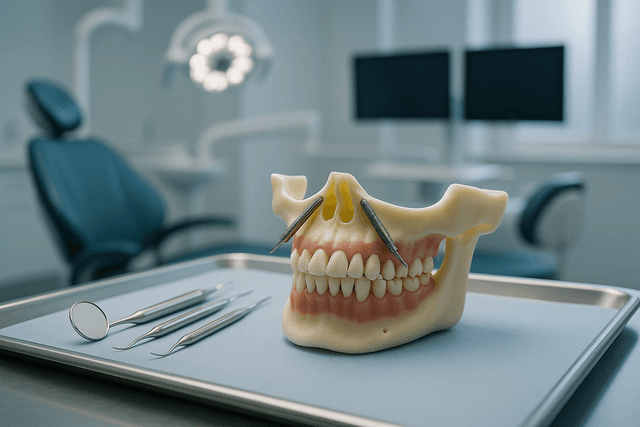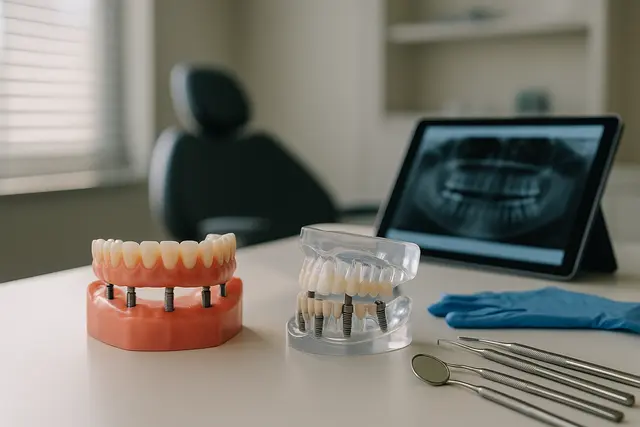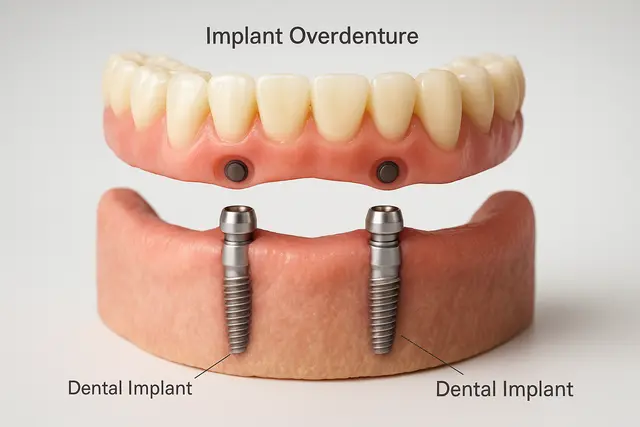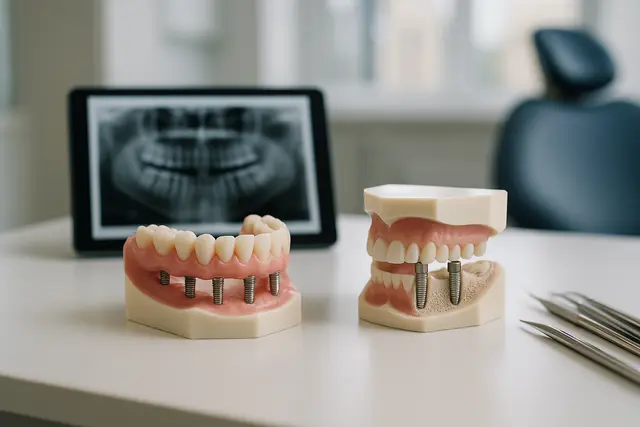Prosthodontics
5 min read
Sep 22, 2025
Are Zygomatic Implants Safe and Effective? Understanding the Procedure
When severe bone loss in the upper jaw makes traditional dental implants impossible, many patients feel like their options run out. Thankfully, modern dentistry offers an advanced solution, zygomatic implants. These specialized implants anchor securely in the cheekbone, providing stability, function, and confidence for those who thought implants were no longer possible.

Implant Solutions When the Upper Jaw Says No
Let’s face it, life throws curveballs. For many people, one of those curveballs is bone loss in the upper jaw, especially after years of wearing dentures or dealing with dental problems. Suddenly, traditional dental implants aren’t an option anymore. The upper jaw doesn’t have enough bone left for support, and a bone graft or sinus lift sounds, well, less than fun.
This is where zygomatic implants come into play. If you’re hearing about them for the first time, you’re not alone. But trust us, these aren’t science fiction. They're a real, proven, and downright clever treatment option for patients who thought implants were off the table.
Zygomatic Implant Basics
So what is a zygomatic implant, exactly? It’s a type of dental implant, but with a twist. Instead of anchoring into the jaw bone (which might not even be there anymore), the implant is placed in the zygomatic bone, aka the cheekbone. That’s one tough piece of anatomy, and it gives your implant a stable, long-lasting foundation.
Zygomatic implants are longer than regular implants, and they bypass the areas of severe bone loss or missing bone by going into the zygomatic arch. Think of it as a workaround with built-in strength. These implants can be placed on one or both sides, and in some cases, two zygomatic implants are used along with traditional implants up front to complete a full upper arch restoration.
Dental Implant Types and Why Zygomatic Is Different
A regular dental implant goes into the jaw bone. Pretty straightforward, until the jaw bone says, “Sorry, not enough of me left.” This happens more often than you’d think, especially after years of missing teeth or poorly fitting dentures. Bone loss naturally shrinks when it's not being used to support teeth.
Enter the zygomatic dental implant. It skips the weak upper jaw and finds a new home in the sturdy zygomatic bone. That means patients can often avoid bone grafts, sinus lifts, or months of healing time. It’s a game-changer.
The Implant Procedure for Zygomatic Cases
Now, let’s talk about the implant procedure. Zygomatic implant surgery isn’t something your average dentist does on a lunch break. This is specialized work, done by an implant specialist with years of training in advanced implant dentistry.
The zygomatic implant procedure usually takes place under sedation or general anesthesia. The dentist or implant specialist uses 3D imaging to plan the exact placement of zygomatic implants. Precision is key here, there’s a lot going on around the implants, including sinus spaces, the cheekbone, and nerves.
Depending on your case, the implants can be immediately loaded, meaning a dental bridge or temporary denture can be attached the same day. That’s right, you walk out with teeth.
Why Choose Zygomatic Implants Instead of a Bone Graft?
Great question. A bone graft involves taking bone from another part of your body (or using donor material) and adding it to the jaw. It can take 6 to 9 months to heal before implant placement is even possible.
Zygomatic implants, on the other hand, often skip the graft altogether. No waiting, no second surgery site, and no hoping the graft “takes.” For people with severe bone loss or those who’ve been told implants are not an option, zygomatic implants offer real hope, and results.
Are Zygomatic Implants Safe?
Here’s the big question: are zygomatic implants safe? We get it. Cheekbone implants sound intense. But the truth is, when performed by experienced professionals, zygomatic implants are a safe and reliable option.
In fact, zygomatic implants are a safe procedure with a high success rate. Studies show a cumulative success rate well above 95%, even in complex cases. The design of zygomatic implants, combined with precise placement and modern imaging, minimizes risk. While every surgery carries some chance of complications, serious complications are rare in skilled hands.
How Zygomatic Implants Work and Why They’re Effective
Let’s demystify how zygomatic implants work. These implants are anchored in the zygomatic bone, which is dense and strong. That solid anchoring makes them very stable, even in patients who’ve had multiple failed implants due to bone loss.
Zygomatic implants can give patients a second chance at a stable smile. Because the implants are placed at an angle and anchored in solid bone, they:
Resist movement
Support chewing
Restore facial shape
Plus, implants can last for decades if cared for properly.
Benefits of Zygomatic Implants You Should Know
Here’s what makes these implants stand out:
No bone graft needed
Fast results, often with same-day teeth
High success rate even in difficult cases
Long-lasting, stable support
A true solution for patients with upper jaw bone loss
Zygomatic implants offer freedom from dentures, facial sagging, and the feeling that nothing works anymore. That’s a win in our book.
What About Complications of Zygomatic Implants?
You’re smart to ask. Like any medical procedure, zygomatic implants come with risks. The most common complication of zygomatic implants is sinus-related discomfort, especially in the early healing phase. But thanks to advancements in imaging and surgical technique, these issues are less common than they used to be.
Other potential concerns include:
Loss of the implant
Implant failure
Nerve irritation
Again, these are rare when the procedure is done by a qualified implant specialist with experience placing zygomatic implants.
Who Should Consider Zygomatic Implants?
If you’ve been told that regular implants are not an option due to bone loss, if a bone graft didn’t work, or if you’ve had multiple failed implants, you may be the perfect candidate.
This type of dental treatment is also ideal for people who want to avoid months of waiting, or who’ve struggled with dentures. Zygomatic implants provide a fast, strong, and long-lasting solution that brings back confidence and function.
What Are Zygomatic Implants and How Do They Work?
Zygomatic implants are a type of dental implant designed for patients with severe bone loss in the upper jaw. Unlike traditional implants that anchor into the jawbone, these longer implants are placed in the zygomatic bone, or cheekbone, which provides a dense and stable foundation. This placement allows patients who are not candidates for regular implants to still receive a secure, long-lasting restoration without extensive bone grafting.
Are Zygomatic Implants Safe and Reliable?
Yes, zygomatic implants are considered safe when performed by an experienced implant specialist. They have a success rate of over 95% in most studies, even in complex cases where bone loss is severe. Advanced imaging and precise surgical planning help reduce risks, and while complications such as sinus irritation or implant failure can occur, they are relatively rare in skilled hands.
What Are the Main Benefits of Choosing Zygomatic Implants?
The biggest advantages include avoiding bone grafts, faster treatment times, and often same-day restoration with functional teeth. Zygomatic implants provide strong support for chewing, help maintain facial shape, and offer long-term stability. They are particularly valuable for patients who have struggled with dentures or failed traditional implants due to bone loss.
Who Is a Good Candidate for Zygomatic Implants?
Zygomatic implants are best suited for patients with significant upper jaw bone loss, those who have been told they cannot receive conventional implants, or individuals who want to avoid lengthy bone graft procedures. They are also an option for patients who want quicker results and a more permanent solution than dentures. A thorough evaluation with 3D imaging will determine if this procedure is right for you.
Read Next
Related Posts

Prosthodontics
Implant Supported Dentures Overview
Missing teeth can impact more than just your smile, they can affect your confidence, comfort, and even your diet. Fortunately, modern dentistry offers a solution that’s both secure and natural-looking: implant-supported dentures. This innovative approach blends the stability of implants with the convenience of dentures to create a long-lasting, life-improving upgrade.
5 min read
Oct 29, 2025

Prosthodontics
Implant Overdentures Explained: The Hybrid Solution to Missing Teeth
Missing teeth can impact everything from your ability to eat to your self-confidence. While traditional dentures have long been a go-to solution, they often fall short in comfort and stability. Implant overdentures offer a modern alternative that combines the security of dental implants with the convenience of removable dentures, a true upgrade for those looking to reclaim their smile.
6 min read
Oct 29, 2025

Prosthodontics
Implant Retained Dentures Explained
Considering implant-retained dentures? You're not alone. As modern dentistry evolves, more people are turning to this secure, natural-feeling alternative to traditional dentures. This guide will walk you through what they are, how they work, and why they might be the solution you've been looking for.
4 min read
Oct 28, 2025
Don’t have time to research every dentist around you?
See why 30k+ patients trusted us